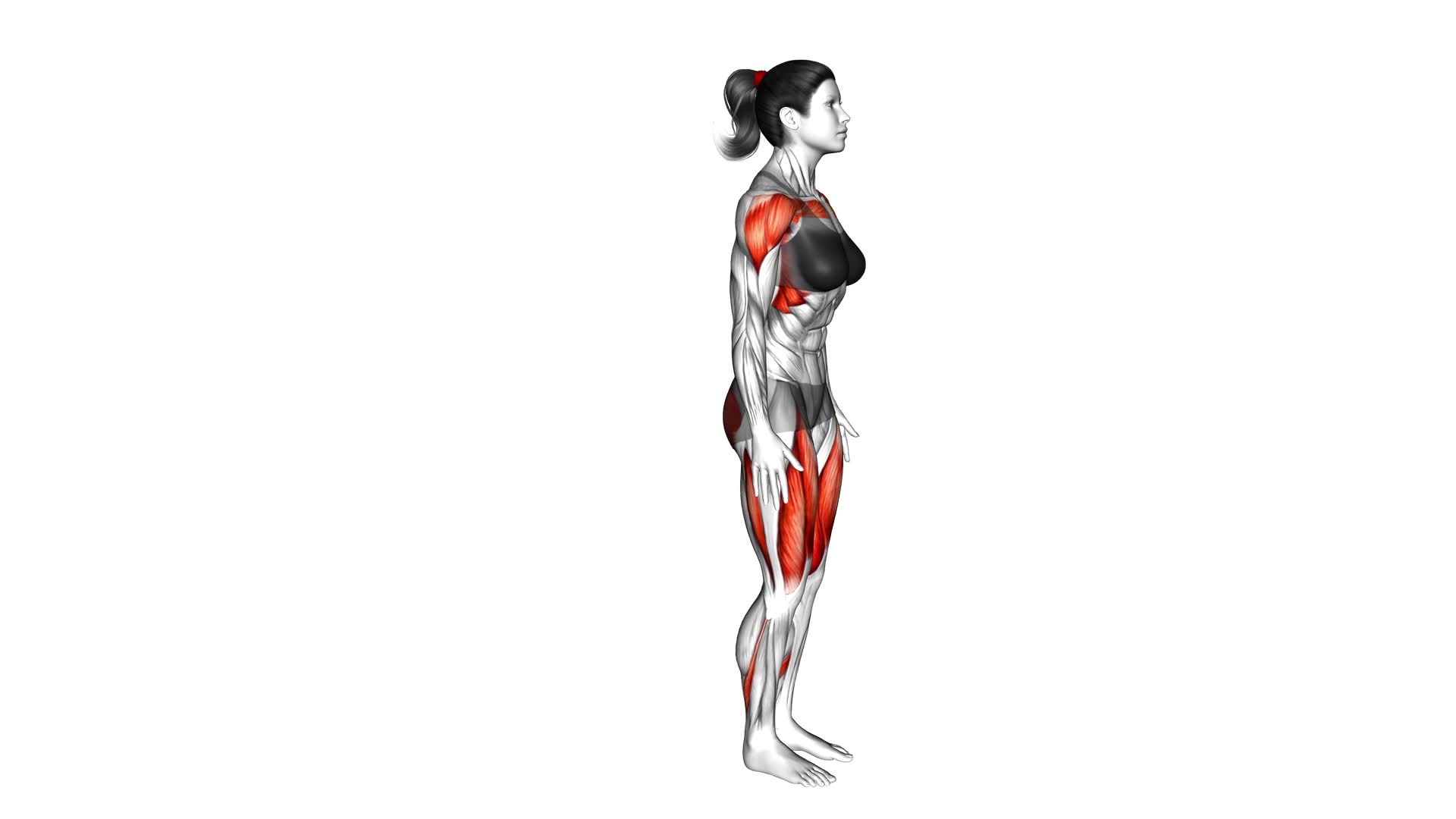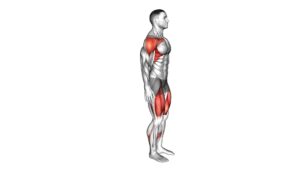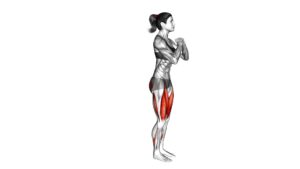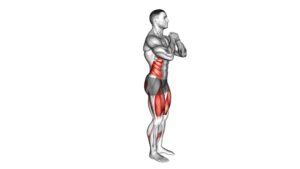Bodyweight Rear Lunge Front Raise (female) – Video Exercise Guide & Tips

Are you looking for a challenging exercise that targets your legs and shoulders? Look no further than the bodyweight rear lunge front raise.
Watch This Exercise Video
This exercise combines the benefits of lunges and shoulder raises, helping you build strength and improve your overall fitness.
In this video exercise guide, we'll show you the proper form and technique, modifications for different fitness levels, common mistakes to avoid, and tips for incorporating this exercise into your workouts.
Get ready to take your fitness to the next level!
Key Takeaways
- The Bodyweight Rear Lunge Front Raise increases strength and stability in the lower body.
- It strengthens leg muscles, including the quadriceps, hamstrings, and glutes.
- This exercise improves shoulder mobility and stability.
- It enhances balance and stability by engaging the core.
Benefits of the Bodyweight Rear Lunge Front Raise
You will experience increased strength and stability in your lower body when you incorporate the bodyweight rear lunge front raise into your fitness routine. This exercise is highly effective in strengthening leg muscles and improving shoulder mobility.
By performing the bodyweight rear lunge, you engage your quadriceps, hamstrings, and glutes, leading to stronger and more toned legs. The lunge movement targets these muscles individually, activating them and promoting muscle growth and definition. This exercise also helps improve your balance and stability as you engage your core to maintain proper form throughout the movement.
Additionally, the front raise component of this exercise targets your shoulder muscles, specifically the anterior deltoids. By raising your arms in front of you while lunging, you activate and strengthen these muscles, improving shoulder mobility and stability. This is particularly beneficial for activities that require lifting or reaching movements, such as carrying groceries or playing sports.
Incorporating the bodyweight rear lunge front raise into your fitness routine not only helps you build stronger leg muscles but also enhances shoulder mobility, making it a valuable exercise for overall strength and stability.
Proper Form and Technique for the Exercise
To perform the bodyweight rear lunge front raise correctly, start by standing with your feet hip-width apart.
Here are three key points to keep in mind to ensure proper form and technique for this exercise:
- Begin by taking a step backward with one foot, lowering your body into a lunge position. Make sure to keep your front knee directly above your ankle and your back knee hovering just above the ground.
- As you lower into the lunge, simultaneously raise your arms out in front of you, keeping them straight and parallel to the ground. This movement engages your shoulders and helps improve upper body strength.
- As you push off with your front foot to return to the starting position, lower your arms back down to your sides. Remember to maintain control and balance throughout the entire movement.
By following these guidelines, you can maximize the effectiveness of the bodyweight rear lunge front raise. It's important to focus on proper form and technique to prevent injury and achieve the desired results.
Incorporate this exercise into your routine to target your lower body and improve your overall strength and stability.
Modifications and Progressions for All Fitness Levels
For modifications and progressions suitable for all fitness levels, consider incorporating variations of the bodyweight rear lunge front raise exercise. Modifications can be made to adjust the intensity and difficulty of the exercise based on individual fitness levels.
If you're a beginner or have limited strength, you can start by performing the exercise without weights. This will allow you to focus on mastering the proper form and technique before adding resistance. As you become more comfortable, you can gradually increase the challenge by incorporating light dumbbells or resistance bands.
To further modify the exercise, you can also decrease the range of motion. Instead of performing a full rear lunge, you can do a partial lunge by only stepping back halfway, or by keeping your front foot stationary and only moving your back foot.
For those looking for a more advanced variation, you can try performing the exercise with heavier weights or incorporating additional movements. For example, you can add a knee lift or a hop after each lunge, or you can perform the exercise on an unstable surface like a balance board or Bosu ball.
Common Mistakes to Avoid While Performing the Exercise
When performing the bodyweight rear lunge front raise exercise, it's important to be aware of common mistakes that should be avoided. Proper form is crucial to maximize the effectiveness of the exercise and prevent injuries. Here are three common mistakes to watch out for:
- Allowing the knee to extend past the toes: As you perform the rear lunge, make sure to keep your front knee directly above your ankle. Allowing your knee to extend past your toes puts unnecessary strain on your joints and can lead to discomfort or injury.
- Arching the back: Maintaining a neutral spine is essential during the exercise. Avoid arching your back or leaning too far forward, as this can cause strain on your lower back. Engage your core muscles and keep your back straight throughout the movement.
- Using momentum instead of controlled movements: It's important to focus on the quality of your movements rather than speed. Avoid using momentum to swing your leg forward or raise your arms. Instead, concentrate on controlled and deliberate movements to engage the targeted muscles effectively.
Tips for Incorporating the Bodyweight Rear Lunge Front Raise Into Your Workouts
Incorporate the bodyweight rear lunge front raise into your workouts for an effective lower body and shoulder exercise. This exercise not only targets your glutes, hamstrings, quadriceps, and shoulders, but it also helps improve balance and stability.
To incorporate this exercise into your routine, start by mastering the basic bodyweight rear lunge front raise. Once you feel comfortable with the movement, you can try incorporating variations of lunges to make the exercise more challenging and keep your workouts interesting. Some variations you can try include reverse lunges, walking lunges, or lateral lunges.
You can also add weights to increase the intensity of the exercise. Remember to maintain proper form throughout the movement, keeping your chest lifted, core engaged, and knees aligned with your toes. It's important to listen to your body and start with lighter weights or no weights at all if you're a beginner. As you progress, you can gradually increase the weight and reps.
Frequently Asked Questions
Can Men Also Perform the Bodyweight Rear Lunge Front Raise Exercise?
Yes, men can definitely perform the bodyweight rear lunge front raise exercise. It's a great exercise for both men and women.
The bodyweight rear lunge front raise helps to strengthen your lower body, particularly your glutes, quads, and hamstrings. Additionally, the front raise targets your shoulders, helping to improve upper body strength and stability.
How Many Calories Can Be Burned by Doing the Bodyweight Rear Lunge Front Raise?
Doing the bodyweight rear lunge front raise is a knee-friendly exercise that can help you burn calories. While the exact number of calories burned varies depending on factors like your weight and intensity, you can expect to burn around 200-300 calories in a 30-minute session.
This exercise targets multiple muscle groups, including your glutes, quads, and shoulders, making it a great addition to your workout routine for overall calorie burn and muscle toning.
Can the Bodyweight Rear Lunge Front Raise Help in Improving Balance?
Improving stability is an important aspect of any exercise routine. The bodyweight rear lunge front raise can definitely help in improving balance. By engaging your leg muscles and core while performing this exercise, you challenge your body's stability and coordination.
However, it's always good to have alternative balance exercises in your workout routine as well. Exercises like single-leg deadlifts or standing on one leg can further enhance your balance and stability.
Is This Exercise Suitable for Individuals With Knee Problems?
If you have knee problems, the Bodyweight Rear Lunge Front Raise exercise may not be suitable for you. It involves placing stress on the knees, which could worsen your condition.
However, there are exercise modifications and alternative exercises that can help you improve your balance without putting strain on your knees.
It's important to consult with a healthcare professional or a certified trainer to find the best options for your specific needs.
Can the Bodyweight Rear Lunge Front Raise Be Done With Weights for Added Resistance?
Yes, you can definitely add weights to the bodyweight rear lunge front raise for added resistance. Using dumbbells will increase the challenge and intensity of the exercise, helping to target and strengthen your muscles even more.
Incorporating weights into your workout routine is a great way to benefit from resistance training, which can improve muscle strength, bone density, and overall fitness.
It's important to start with lighter weights and gradually increase as you become more comfortable and stronger.
Conclusion
Incorporating the bodyweight rear lunge front raise into your workouts can provide numerous benefits. This exercise is great for improving lower body strength and shoulder mobility. By following proper form and technique, you can ensure maximum effectiveness and minimize the risk of injury.
With modifications and progressions available for all fitness levels, this exercise can be tailored to suit individual needs. Whether you're a beginner or advanced, you can adjust the intensity to challenge yourself.
Avoiding common mistakes will further enhance the results. It's important to maintain proper alignment and control throughout the movement. Engage your core and focus on maintaining stability.
Add this exercise to your routine for a challenging and effective workout. It's a great way to target multiple muscle groups and improve overall strength and mobility. Take your time to learn the correct technique and gradually increase the difficulty as you progress.

Author
Years ago, the spark of my life’s passion ignited in my mind the moment I stepped into the local gym for the first time. The inaugural bead of perspiration, the initial endeavor, the very first surge of endorphins, and a sense of pride that washed over me post-workout marked the beginning of my deep-seated interest in strength sports, fitness, and sports nutrition. This very curiosity blossomed rapidly into a profound fascination, propelling me to earn a Master’s degree in Physical Education from the Academy of Physical Education in Krakow, followed by a Sports Manager diploma from the Jagiellonian University. My journey of growth led me to gain more specialized qualifications, such as being a certified personal trainer with a focus on sports dietetics, a lifeguard, and an instructor for wellness and corrective gymnastics. Theoretical knowledge paired seamlessly with practical experience, reinforcing my belief that the transformation of individuals under my guidance was also a reflection of my personal growth. This belief holds true even today. Each day, I strive to push the boundaries and explore new realms. These realms gently elevate me to greater heights. The unique combination of passion for my field and the continuous quest for growth fuels my drive to break new ground.







